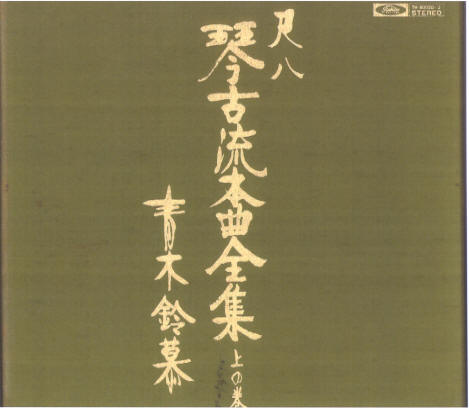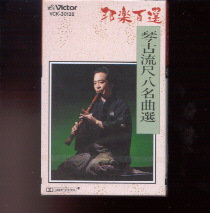Aoki Reibo II
二世 青木 鈴慕

10/4/1935 - 8/21/2018
Shakuhachi
|
Aoki learned shakuhachi from his father, Reibo Aoki I and became head of that lineage in 1975 becoming Reibo Aoki II. Head of the Reibo-kai Shakuhachi Guild, Aoki was an extremely strong, powerful player with a highly disciplined technique. His rich sound and stunning performances in both the classical Kinko style and contemporary music became a standard in shakuhachi music. Aoki's performances of "Shika no Tone" in tandem with Goro Yamaguchi are considered definitive. The Teizo Matsumura composition "Shikyoku Ichiban" has become a standard of Modern Hougaku Genre where standards are few. Aoki's first major tour abroad came in 1973, a forty day Japan Foundation sponsored tour of North America and Europe. Recently, in 1996 and 1997, Aoki traveled to China as a member of a friendship tour arranged by the Japanese Cultural Exchange Society. His vast discography which includes the award-winning "Take Ippon - Aoki Reibo" on Crown Records continues to inspire shakuhachi enthusiasts as a source of 'authentic' sound. Aoki was designated as a "Living National Treasure"in 1999. Impressions of Reibo Aoki Reibo Aoki, besides demonstrating a profound understanding of a wide range of pieces, from classic solo to modern works, astounds the ears of his listeners as a musician of great appeal who can draw them into a world of his own. As a performer who truly experiences modern times, he is always creating new impressions, and his self-confidence in his music overflows. His performances, without the slightest faltering, are controlled with great intelligence, but are far from being merely intellectual – they make one feel the physical liberation of breath as he plays Inspired by breath, and from this inspiration instilled in the art of classical Japanese music, Mr. Aoki moves the audience to admiration. -- Haruhiko Kindaichi Born into a family of shakuhachi players, Mr. Aoki has played shakuhachi ever since he can remember. He began lessons with his father at age six, and ten years later he began his career as a shakuhachi performer. After the death of his father when Mr. Aoki was nineteen, he pursue his goals without a teacher, and by his twenties was already one of the most well known shakuhachi artists in Japan. Now about to begin his fifth decade, Mr. Aoki has played a wide range of classical as well as contemporary solo and ensemble pieces, has composed works of his own, has travelled worldwide to perform and made numerous recordings and radio and television appearances. He also has many students. Because the shakuhachi is peculiarly rich in shades of tone, the mastery of these sounds can be extremely effective. Thus it is often said of a great shakuhachi artist that one can hear the sound of his soul as he plays. No less can be said of Mr. Aoki. His success lies not merely in his superb musical training-and technique, but in his ability to communicate the essence of the instrument to his listeners. -- Elizabeth Bennett
|
| También Conocido Como 青木静夫 (Aoki Shizuo) |
|
Profesores Estudiantes
Elizabeth Reian Bennett Kobayashi Reijun Kuroda Reison Mitsuka Yukihiko 1954 - Omata Seiryū 1914 - ???? Sano Reihi Satō Reishō 1916 - ????
James Nyoraku 如楽 Schlefer 1956 - |
Álbumes
Pistas Grabadas
Compuesto o Arreglado
| Shakuhachi Obras | |||
| Título | Kanji | Año | Título Alternativo |
| Raika II | |||
| Range of a Shakuhachi, The | |||
| Special Shakuhachi Techniques | |||
| Stream | ストリーム |
Stream | |
| Takefū Dai San Ban | 竹風第三番 |
Bamboo Wind #3 | |
| Hanabi | 花火 |
1966 |
|
| Hakusa no Shi | 白砂の詩 |
1967 |
|
| Gorin | 五輪 |
1982 |
|
| Karin | 華林 |
1983 |
|
| Shamisen | |||
| Monogatari Hitotsu | 物語一つ |
1982 |
A Story |






























